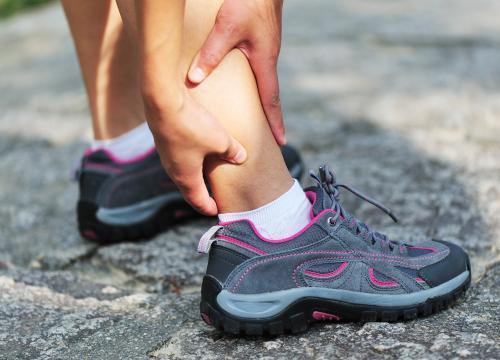Dystonia in PD
Dystonia is a continuous or repetitive muscle twisting, spasm or cramp that can happen at different times of day. Curled, clenched toes or a painful, cramped foot are telltale signs of dystonia. Dystonia can occur in different stages of Parkinson’s disease (PD). For example, dystonia is a common early symptom of Young Onset Parkinson’s, but it can also appear in middle to advanced stages of Parkinson’s.
What is Dystonia?
Dystonia often happens when the person with PD tries to perform an action with the affected body part. For example, if you have dystonia of the foot, you may feel fine when sitting, but you may develop toe curling or foot inversion (turning in of the foot or ankle) when trying to walk or stand. Dystonia can also happen when you are not using the involved body part. Some dystonia happens unrelated to an action or movement — like toe curling while sitting.
People with PD often experience a painful dystonia on the side of their body with more Parkinson’s symptoms. This frequently happens first thing in the morning when dopamine levels are at their lowest, or as nighttime medications wear off, or may come and go throughout the day. This painful cramp may go away after the first daily dose of Parkinson’s medications or may not relate to timing of medication at all.
Foot dystonia is one of the most common sources of dystonic pain, specifically in early PD, but dystonia can affect other body parts. In addition to cramping, it can cause forceful twisting movements. A common example is when a person’s arm feels pulled behind their back or their head is pulled to the side or toward the chest. Severe and painful spasms also can occur in the neck, face or throat muscles.
These movements are different from the flowing, writhing movements of dyskinesia (involuntary, erratic, writhing movements of the face, arms or trunk) which are not usually painful.
Although dystonia can be a Parkinson’s symptoms, people can experience dystonia without having Parkinson’s. Whether or not a person with dystonia has Parkinson’s, it is often treated with the same medications.
Parts of the Body Affected by Dystonia
- Arms, hands, legs and feet: Involuntary movements, spasms or twisting and "curling"
- Neck: May twist uncomfortably, causing the head to be pulled down or to the side. This is called cervical dystonia or spasmodic torticollis
- Muscles around the eyes: May squeeze involuntarily, leading to a person to blink too much or to have difficulty opening the eyes. This is also called blepharospasm
- Vocal chords and swallowing muscles: May cause a person's voice to sound softened, hoarse or breathy
- Jaw: May open or close forcefully or there may be grimacing of the face
- Abdominal wall: May cause sustained contractions and involuntary, writhing movements of the abdominal wall
Managing Dystonia
It can be helpful to keep track of when dystonia occurs to find a relationship between the onset of dystonia and the timing of your medication. Your doctor may ask you some of the following questions to see if there is a pattern:
- Do you experience dystonia when levodopa (Sinemet) is at a peak (also known as an "on" period)?
- Do dystonia symptoms happen before the first dose in the morning or when medication is wearing off?
With your physician’s direction, adjusting the dose or frequency of medication may help relieve dystonia. Those with morning dystonia (before the first dose of levodopa kicks in), may be advised by their doctor to add a bedtime dose of controlled- release carbidopa-levodopa or a long-acting dopamine agonist.
Therapies to Manage Dystonia
Physical and occupational therapy are also options for managing dystonia. It may be difficult to exercise when you are in pain. However, if you are in pain while moving and suddenly stop, the pain can get worse. A physical or occupational therapist can recommend exercises or techniques to target the source of your pain and to stretch and strengthen the body parts most affected by dystonia.
Botulinum Toxin Injections
If various therapies fail and your dystonia is not helped by altering medication timing, you and your healthcare provider may consider Botulinum toxin.
(BOTOX®) injections. Botulinum toxin weakens muscles, which helps calm the overactivity caused by dystonia. By targeting the overactive muscles, your physician can decrease the discomfort and pain caused by dystonia. It can take several injections to work well and it may not always be effective. When it does work, the benefit can last for several months before it wears off and re- injection is necessary.
Botulinum toxin A (BOTOX®): Can be used to treat dystonia as it stops unnecessary nerve signals from firing. It can also be used to decrease saliva production for people who have issues with drooling.
Botulinum toxin B (Myobloc): Primarily used to treat dystonia. Botulinum toxin B can cause dry mouth when used for dystonia, but unlike Botulinum toxin A, it is not approved by the U.S. Food and Drug Administration (FDA) for drooling.
Deep Brain Stimulation
Deep brain stimulation (DBS) surgery may also, in some cases, help dystonia in Parkinson’s. DBS is a standard treatment for specific types of dystonia when it is not associated with Parkinson’s. Its role as a treatment for dystonia in Parkinson’s is being researched.
For dystonia, the electrical leads can be placed in the same brain regions used in Parkinson’s disease. Health practitioners are also trying to use new DBS technologies that better target Parkinson’s symptoms.
Related Materials
Related Blog Posts

Strategies and Tips for Dealing with Dystonia

Walking with Parkinson’s: Freezing, Balance and Falls
